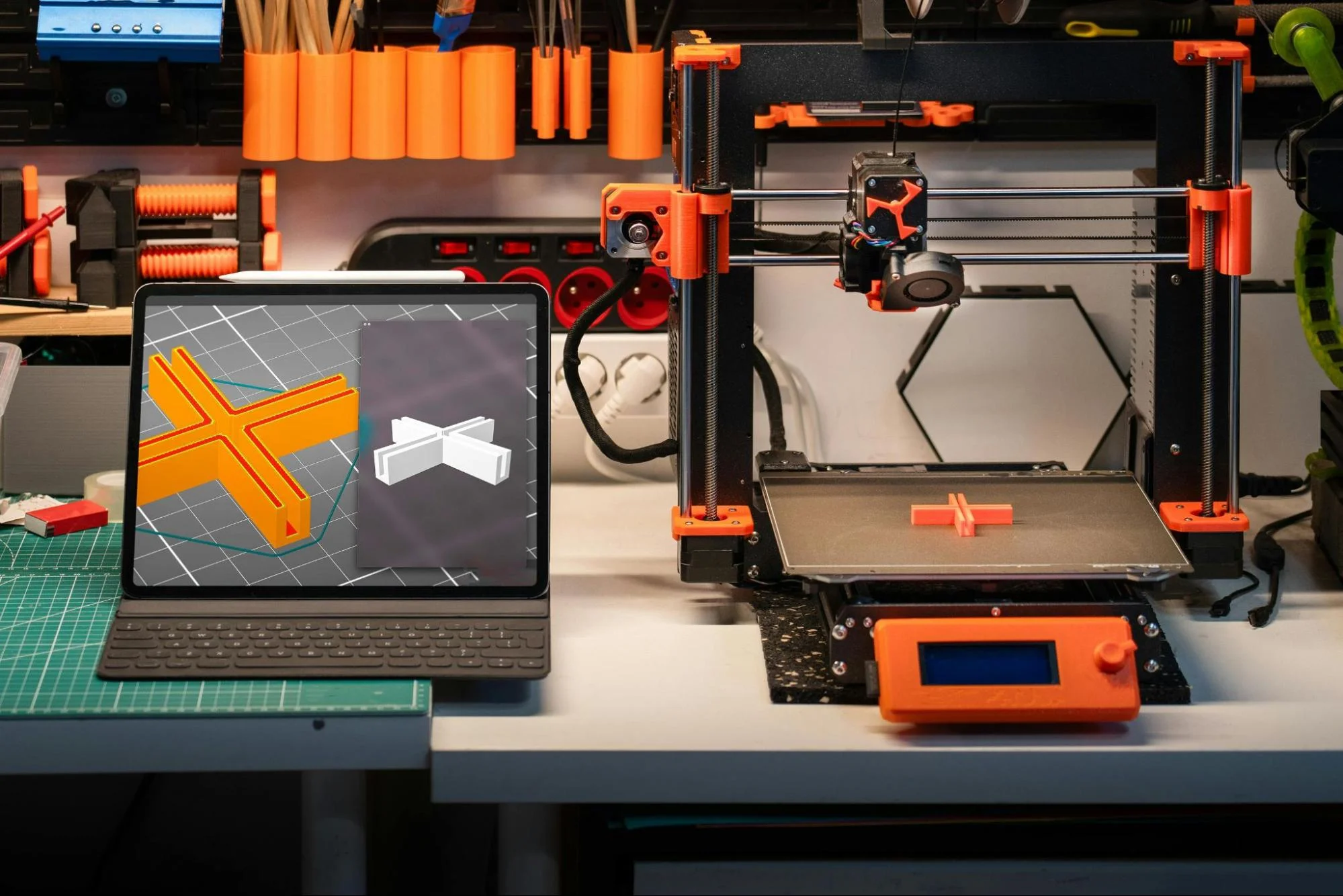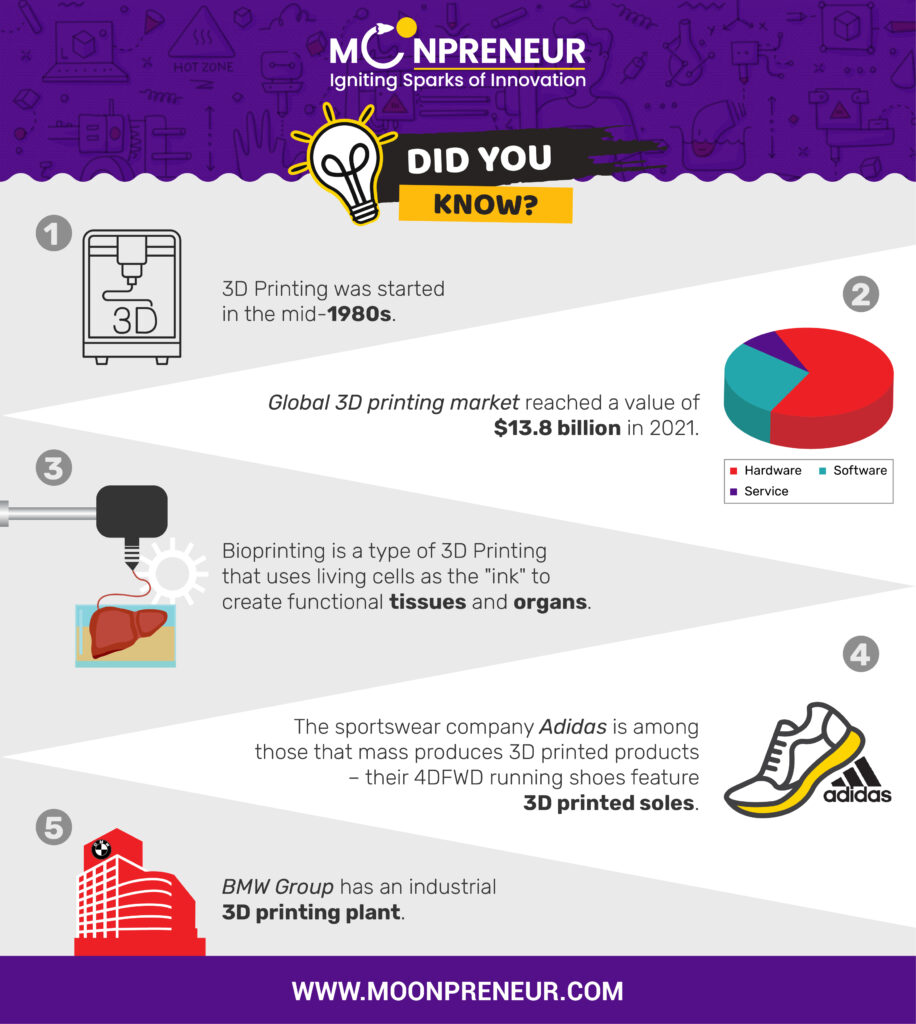
Update: This article was last updated on 7th January 2026 to reflect the accuracy and up-to-date information on the page.

3D printing can be an engaging and educational activity for people of all ages, including children. However, it’s important to consider the complexity and safety of the 3D printing process when determining an appropriate age for a child to use a 3D printer.
For very young children under 8 years old, it may be more appropriate to use a 3D printing pen or other simple crafting tools to create basic 3D shapes. As children get older and gain more fine motor skills, they may be ready to use a 3D printer with adult supervision.
Here, I will answer a few burning questions that will run through every child’s mind regarding 3D Printing and the processes used. I will also help you understand the very basics of this science and the benefits you can reap!
What is 3D Printing?
3D printing is a process of creating a physical object from a digital model. It involves using a 3D printer, which is a machine that prints successive layers of material to build up an object.
To create an object using 3D printing, you first need to design a digital model using computer-aided design (CAD) software. The digital model is then converted into a format that the 3D printer can understand and use to build the object layer by layer.
3D printing can be used to create a wide range of objects, from simple shapes to complex structures with intricate details. Younger children enjoy creating simple shapes or characters, while older children can tackle more complex projects, such as designing and printing their toys or gadgets.
Similar interest: Realize Your Future Possibilities
What materials does one use for 3D Printing?
3D printing, also known as additive manufacturing, is a process that creates a three-dimensional object by building it layer by layer from a digital model. A wide variety of materials can be used in 3D printing, including plastics, metals, ceramics, and even living cells.
Some common materials used in 3D printing include:
Plastics: Polylactic acid (PLA), acrylonitrile butadiene styrene (ABS), and polyethylene terephthalate (PET) are some of the most commonly used plastics in 3D printing. These materials are relatively inexpensive and easy to work with, but they may need to be stronger and more durable than some other materials.
Metals: 3D printing with metals allows for the creation of complex, high-strength parts. Common metals used in 3D printing include steel, aluminum, titanium, and copper.
Ceramics: Ceramic materials can be used in 3D printing to create objects with a high level of detail and a smooth surface finish.
Living cells: 3D printing with living cells, also known as bioprinting, has the potential to revolutionize medicine by allowing the creation of replacement tissues and organs.
Similar interest: Learn product design course
What are the popular techniques used for the 3D Printing process?
3D printing, also known as additive \manufacturing, is a process that creates a three-dimensional object by building it layer by layer from a digital model. There are several different techniques and processes used in 3D printing, including:
- Fused Deposition Modeling (FDM) is the most common type of 3D printing process. It involves melting plastic filament and depositing it layer by layer to build up the object.
- Stereolithography (SLA): This process uses a laser to cure layers of liquid resin into a solid object.
- Selective Laser Sintering (SLS): This process uses a laser to sinter, or partially melt, layers of powdered material, such as metal or plastic, into a solid object.
- Digital Light Processing (DLP) uses a projector to cure layers of liquid resin into a solid object.
- Continuous Liquid Interface Production (CLIP): This process uses a light projector and oxygen to cure layers of liquid resin into a solid object.
The specific process used will depend on the material being used, the complexity of the object being printed, and the capabilities of the 3D printer.
Similar Interest: Moonpreneur-Prototyping Kit Soil Moisture Meter
Exploring 3D Printing for Kids: Making Learning Fun and Creative
Hands-on 3D Printing Projects for Kids
Introducing 3D printing for kids through fun and practical projects is a great way to spark creativity. Simple projects like designing a personalized keychain, creating geometric shapes, or printing characters from their favorite stories can captivate younger kids. For older children, projects such as building functional gadgets, model prototypes, or even mini architectural structures can provide an exciting challenge. These activities not only make learning enjoyable but also allow kids to see the tangible results of their efforts, fostering a sense of pride and accomplishment in their parents and educators.
Why 3D Printing for Kids is a Game-Changer in Education
3D printing for kids isn’t just about creating extraordinary objects—it’s a powerful educational tool. It bridges the gap between theoretical knowledge and practical application. For instance:
- In math, kids can learn geometric concepts by designing and printing 3D models.
- In science, they can experiment with material properties and structural stability.
- In art, they can unleash their imagination to design and print artistic creations.
- By introducing 3D printing for kids, you’re helping them gain skills that are highly relevant in today’s technology-driven world.
Tips for Safe 3D Printing for Kids
While 3D printing for kids is exciting, safety is a priority. Here are some tips to ensure a safe experience:
- Always supervise young children when using a 3D printer.
- Educate kids about handling heated parts and sharp tools carefully.
- Opt for beginner-friendly 3D printers with built-in safety features.
- Use non-toxic and eco-friendly filaments like PLA, which are safer for kids.
Choosing the Right 3D Printer for Kids
When exploring 3D printing for kids, it’s essential to select a printer that matches their age and skill level. Beginner-friendly models such as XYZprinting da Vinci Mini or Creality Ender-3 are great options. These printers are affordable, easy to use, and come with helpful tutorials that simplify the learning process.
The Future of 3D Printing for Kids
As technology evolves, 3D printing for kids will continue to grow in popularity. Schools, libraries, and maker spaces are increasingly incorporating this technology into their programs, making it more accessible. By equipping children with 3D printing skills, we prepare them for an innovative future where creativity and problem-solving go hand in hand. This future potential of 3D printing for kids should excite and inspire parents and educators.
Discover Moonpreneur’s Product Design Course
Moonpreneur’s online program introduces 3D printing to kids in a fun and engaging way. Through expert-led sessions, kids learn to design and create with CAD software, explore different 3D printing techniques, and even integrate their creations into entrepreneurial projects. With Moonpreneur, kids don’t just learn—they innovate, creating a foundation for future success in STEM fields.
Encourage your child to explore the endless possibilities of 3D printing for kids. Sign up today and watch their imagination come to life!
How Is Learning 3D Printing Beneficial For Kids?
3D printing can be an important tool for kids to learn and explore their creativity and problem-solving skills. It allows kids to take a digital design and bring it to life as a physical object, which can be a unique and rewarding experience.
Here are some key benefits of teaching 3D printing to kids:
- Encourages creativity: 3D printing allows kids to create and design their objects, which can be a great way to encourage creativity and imagination.
- Develops problem-solving skills: 3D printing involves troubleshooting and problem-solving, as kids may need to adjust their designs or troubleshoot issues that arise during the printing process.
- Introduces kids to new technologies: 3D printing is a cutting-edge technology that is used in a variety of industries. Introducing kids to 3D printing can help them become familiar with new technologies and may spark an interest in STEM (science, technology, engineering, and math) fields.
- Enhances learning: 3D printing can be a fun and engaging way for kids to learn about a variety of subjects, such as geometry, physics, and engineering. It can also bring concepts from the classroom to life, making them more tangible and easier to understand.
- Promotes teamwork and collaboration: 3D printing projects can be a great opportunity for kids to work together and collaborate on a common goal.
Is 3D printing gaining popularity among kids?
3D printing has become increasingly popular in recent years, and it has been embraced by people of all ages, including kids. Many schools and libraries now have 3D printers available for students to use, and there are also a number of 3D printing clubs and camps specifically designed for kids.

In addition, there are a number of easy-to-use 3D printers on the market that are specifically designed for kids and beginners. As 3D printing technology continues to advance and become more accessible, it will likely continue to gain popularity among kids.
At Moonpreneur, we provide a few pointers while introducing our students to 3D printing to make learning fun and educational.
- Age: 3D printing involves working with small parts and using technology, so it may not be suitable for children under the age of 8. However, older kids and teenagers can often handle the complexity and technical aspects of 3D printing.
- Safety: 3D printers use heated extruders to melt and print with plastic, so it’s essential that you, as a parent, supervise your kids and make sure they understand the dangers of the printer they are using.
- Learning resources: Our online program is taught by industry experts and helps kids learn about 3D printing and how to use CAD software.
Moonpreneur understands the needs and demands this rapidly changing technological world is bringing to our kids. Thus, our holistically created online Product Design course will help kids master the art of 3D printing and PCB Design. Enroll your child today!
Moonpreneur is on a mission to disrupt traditional education and future-proof the next generation with holistic learning solutions. Its Innovator Program is building tomorrow’s workforce by training students in AI/ML, Robotics, Coding, IoT, and Apps, enabling entrepreneurship through experiential learning.























My kid had just gone through experiencing 3D printing with me for the first time, and it was a really fun learning experience! We began with a simple design of a keychain, and to see how well that turned out was magic. That’s so amazing how quickly kids catch on at the basics and start composing with their imagination.
3D printing opens up so many possibilities for kids to explore creativity and problem-solving. Has anyone tried creating something unique or functional with their kids? I’m thinking of trying a pencil holder or a small toy next.
A fun tip for beginners: start with free online 3D modeling tools like Tinkercad, which will design simple objects before moving to more complex projects. It’s super kid-friendly and a great way to ease into the world of 3D printing.